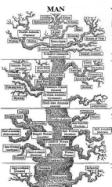|
from The Worldview Literacy Book copyright 2009 back to worldview theme #25 |
|
Discussion
Worldviews built on anthropocentrism take a human being centered
viewpoint that sees humans as the most important thing in the universe,
and assigns value to other things based on their usefulness to humans.
It promotes belief in human
exception- alism—the idea that humans are special and stand apart from
the rest of nature and the universe.
(This is diametrically opposed to "Belonging to Nature"
worldview theme #27 which so called deep ecologists value.) Some
cite humans' extra-ordinary brains and aptitudes to support this belief;
others make the claim for religious reasons believing God created man to
have dominion over nature ( Figure #25b).
The Bible suggests this in Genesis: "Let us make man in our
image, after our likeness: and let them have dominion over the fish of
the sea, and over the fowl of the air, and over the cattle, and over
every creeping thing that creepth upon the earth."
It also provides related instructions to "Be fruitful, and
multiply, and replenish the earth, and subdue it: and have dominion
over...every living thing." (Some dispute this translation and suggest the original
Hebrew communicates a gentleness and familiarity that is less
subjugation and more like stewardship.)
Some scholars connect anthropocentrism with Western civilization
and link its origins to Christianity.
Most notably UCLA historian Lynn White, Jr. does this in a 1967
paper "The Historical Roots of Our Ecologic Crisis."
There he describes a pre-Christian, animist worldview as follows:
"[E]very tree, every spring, every stream, every hill had its
own...guardian spirit. These
spirits were accessible to men...Before one cut a tree, mined a
mountain, or dammed a brook, it was important to placate the spirit in
charge." By destroying pagan animism and belief that gods were
everywhere in nature, "Christianity made it possible
to exploit nature in a mood of indifference to the feelings of natural
objects," White contends. After
noting the failure of Saint Francis (patron saint of animals, birds and
the environment) to successfully promote "the equality of all
creatures, including man" as an alternative to the ingrained
teaching that "nature has no reason for existence save to serve
man" he concludes, "Both our present science and...technology |
Discussion—continued from them alone."
In 1973 deep ecology founder Arne Næss blasted shallow ecology
as a "fight against pollution and resource depletion" to
promote "the health and affluence of people in the developed
countries." John
Passmore responded with Man's
Responsibility for Nature: "[M]an's great memorials: his
science, his philosophy, his technology, his architecture, his
countryside...all of them founded upon his attempt to understand and
subdue nature" show that human transformation of the natural
environment "can make the world more fruitful, more diversified,
and more beautiful." Passmore
wasn't arguing for continued exploitation of nature and destruction of
natural beauty. He recognized
"man's utter dependence on nature...and [its] vulnerability to human
depredations." He felt
that humans should cooperate with nature and increasingly practice stewardship:
responsible, caring management of something (natural resources, a tract
of land, etc) that is entrusted to them.
Eventually deep ecologists characterized his proposed solutions to the ecologic crisis as anthropocentrism and
utilitarianism.
By the late 1970s, a movement was growing that deep ecologists
would like a great deal less: the wise
use movement. Led by people who felt the government had no right
dictating what private landowners could and could not do with their
land, this movement overlapped with the "Sagebrush Rebellion"
in the western United States. It
grew out of concern over public land management practices and
frustration with laws containing environmental restrictions, protecting
endangered species, limiting development, etc.
"Wise use" refers to a philosophy about how land should
be developed, a philosophy supposedly based on common sense.
There is a strong "Economic Individualism" and
"Libertarian" (worldview themes #19 and #50A) undercurrent in
this movement. It values private
property rights and regards government challenges to them as threats to
individual freedom. Figure
#25c presents a toned down, idealized version of
"Wise Use Movement Articles of Faith."
By the first decade of the 21st century, as international efforts
calling for nations to reach agreement on limiting greenhouse gas
emissions floundered, serious consideration of global climate
engineering began. (See
Figure #25a below.) |
|
||||||||||||
|
Figure
#25b: The Great
Chain of Being
|
Figure
#25c: Wise
Use Movement's Articles of Faith?
|
|||||||||||


